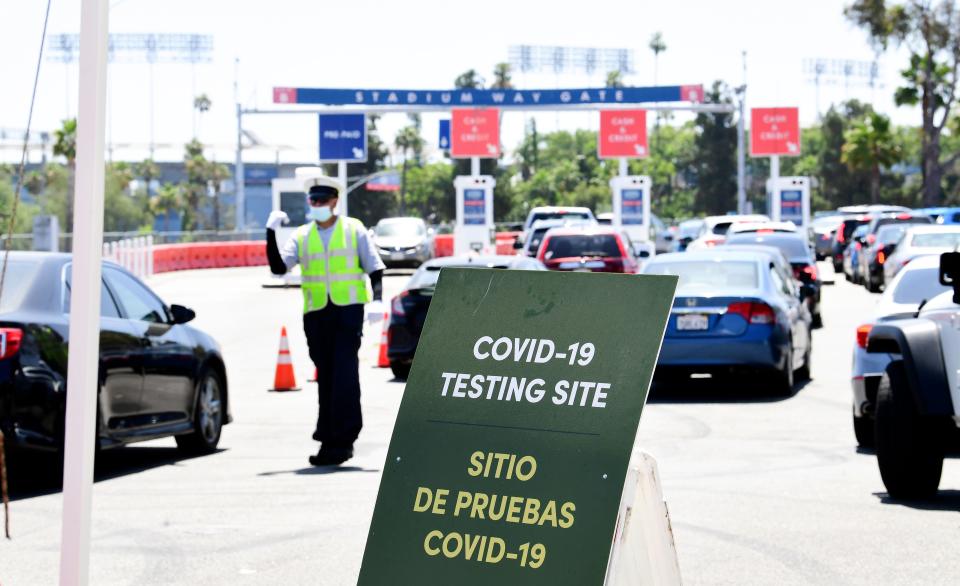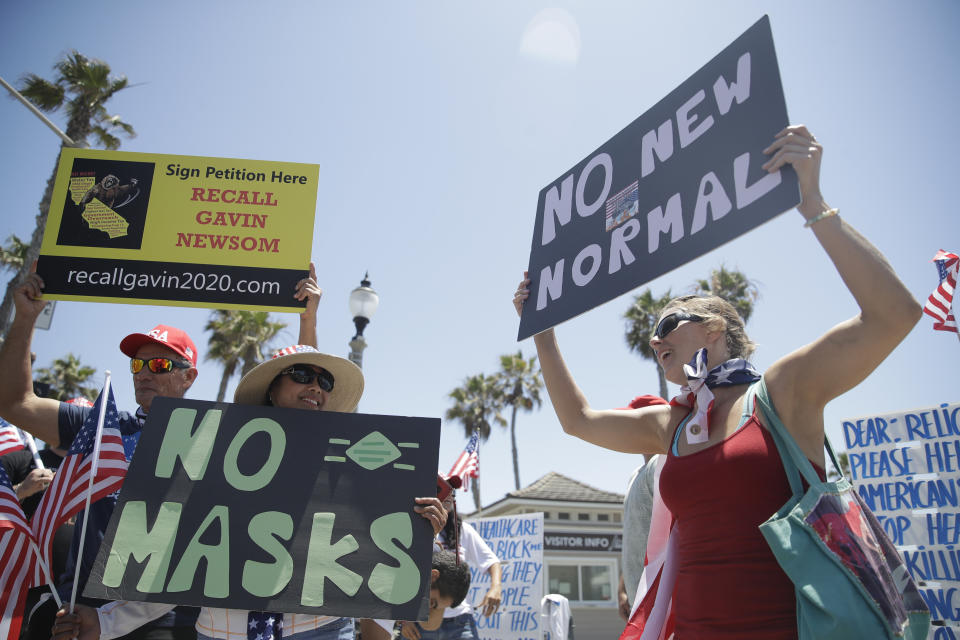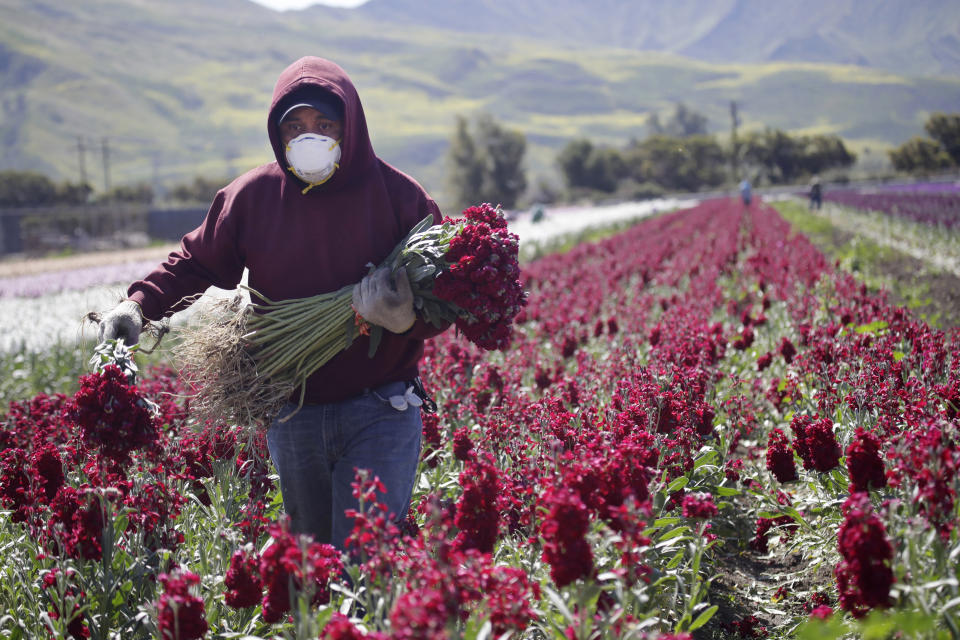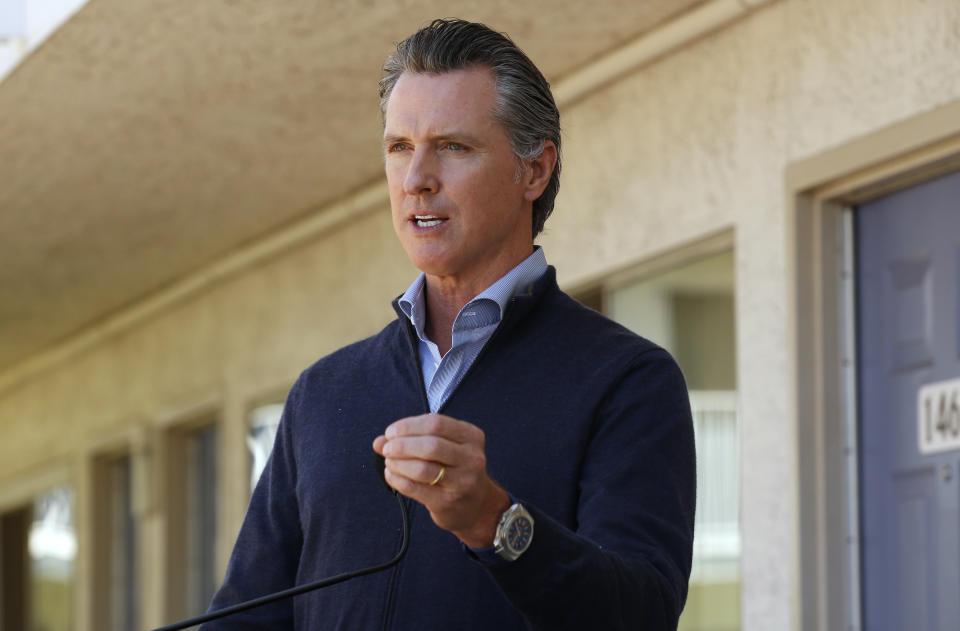Racial and economic inequality are supercharging the coronavirus surge in states like California
LOS ANGELES — California was supposed to have the coronavirus under control. Then people went back to work.
On March 16, health officers in six Bay Area counties jointly ordered residents to shelter in place — the first such order in the nation. Eleven other California counties immediately followed suit, and on March 19 Gov. Gavin Newsom expanded the rule to cover the entire state — three days before New York implemented a similar order. Mobility plummeted, and as cases and deaths soared elsewhere, the numbers in California remained surprisingly low, never rising to the level expected in America’s most populous state.
“We do see that their curve is different,” Dr. Deborah Birx, the U.S. coronavirus response coordinator, said in April. “And we really believe that the work that every citizen is doing in [California] is making a difference.”
Yet now here we are. Over the past week, California’s case count has skyrocketed, surpassing 200,000 known infections. The state reported 9,740 new cases on Wednesday, topping the previous single-day record set here the day before. The number of hospitalized Californians, meanwhile, has shot up nearly 50 percent over the past two weeks, prompting Newsom to backtrack Wednesday on reopening and order 19 counties, including Los Angeles, to halt visits to indoor restaurants, entertainment centers, movie theaters, zoos, museums and card rooms — while pressuring the state’s hardest-hit county (Imperial) to reinstate its recently lifted stay-at-home order.
Suddenly, the national media is mentioning California in the same breath as Florida, Arizona and Texas — as one of the reeling Sun Belt states where COVID-19 is staging its unwelcome comeback.
Yet the conventional wisdom about Florida, Arizona and Texas is that they never took the coronavirus as seriously as they should have, packing beaches and bars and refusing to wear masks (including at President Trump’s recent campaign event in Phoenix).
California, in contrast, locked down aggressively. Its leaders never dismissed the threat. Newsom issued a mandatory mask order. And while epidemiologists have braced for a spike in cases tied to last month’s mass George Floyd protests, that spike hasn’t come.
So what went wrong?

The answer may help deepen our understanding of the real reasons COVID-19 has come roaring back and shape how we combat the deadly pathogen in the weeks and months ahead. Because even though blaming the virus’s resurgence solely on reckless personal behavior can be a satisfying exercise in online schadenfreude — You partied at a bar? Maskless? Well, you got what you deserved — it’s only half the story.
The other half is about all the people who did exactly what we told them to do when America “reopened”: They left home and started working again.
The first thing to note about California’s current outbreak is that it isn’t as dire as Florida’s, Texas’s or Arizona’s — at least not yet. Republican leaders, including President Trump, have long claimed the real reason cases are rising across the South and West is simply that we’re testing more people and thus detecting more infections. That’s mostly untrue in Arizona, Florida and Texas, where record-breaking case counts — Arizona (4,797) and Texas (7,947) set new records Tuesday; Florida’s high (9,585) was Saturday — are rising a lot faster than the total number of tests.
But it’s still partially true in California, where the rolling seven-day average of new daily tests has shot up by nearly 49 percent over the past two weeks, to more than 92,000 per day.
To see the difference, check out the percentage of tests that are coming back positive. Arizona’s average positive-test rate has nearly tripled from 8.84 percent on June 1 to 24.43 percent on June 29. Florida’s has quadrupled from 3.85 percent to 15.62 percent. Texas’s has shot up from 5.42 percent to 14.11 percent.
In California, the average positive-test rate was 5.01 percent on June 1. Today it’s 5.95 percent.

Even so, California’s once-stable numbers are now heading in the wrong direction — and the backslide is particularly pronounced in key areas such as Los Angeles County, where the average positive-test rate is approaching 9 percent (up from 5.8 percent two weeks ago). The World Health Organization’s “acceptable” positivity rate is 5 percent or lower, and U.S. experts have used 10 percent as the threshold to determine when a flareup is getting out of control.
The accepted national narrative says that restless, irresponsible residents — especially the cocky young ones who assume COVID-19 won’t kill them — are responsible for this spike. In an analysis headlined “California’s slide from coronavirus success to danger zone began Memorial Day,” the Los Angeles Times backdated the state’s turning point to the May 25 holiday weekend after calculating that hospitalizations “began accelerating around June 15 at a rate not seen since early April” — the telltale two- to three-week lag for incubation.
“As the reopening accelerated, a lot of people were ready to get out,” the paper explained. “The beckon of summer rituals followed — day trips to the beach, Memorial Day barbecues, graduation celebrations, Father’s Day gatherings.”
The New York Times followed with a story that put the onus on “millions of individual decisions made across the vast state” as the result of “a decentralized, haphazard process that sowed confusion and gave residents a false sense that they were in the clear.”
“Unlike people in the Northeast, many Californians did not have a sense of urgency or immediacy toward the virus because infection rates had been so low for months,” the Times continued. “There were no overflowing morgues or ambulance sirens at all hours.”
The press isn’t wrong. Careless behavior has undoubtedly played a big role in California’s coronavirus resurgence. Even in liberal L.A., resistance to masking up is real; the local taqueria Hugo’s closed indefinitely over the weekend because staffers were “exhausted by the constant conflicts over guests refusing to wear masks,” which included being “harassed, called names and [having] objects and liquids thrown at them.” As Barbara Ferrer, public health director for Los Angeles County, put it Monday, “We’ve had numerous examples of outbreaks happening because families are getting together with extended family members and friends to celebrate weddings, things they had postponed.”
But casting stones at people who seem to have taken unnecessary risks obscures another factor clearly at work in California — perhaps more clearly here than anywhere else.

“I’ve had an explosion of new outbreaks in workplaces,” Ferrer added Monday. “One that got shut down this past weekend, it had over 115 infections.”
The fact is, both sides are at risk when reopening a state for business: customers, yes, but also workers — blue-collar workers in particular. And because customers come and go in relative isolation while workers interact with hundreds or even thousands of customers per day — and operate for hours on end in precisely the kind of close quarters where the coronavirus thrives — workers are almost certainly at greater risk of getting sick.
One small L.A. bakery, Bub and Grandma’s, shut down last week after six of its employees tested positive — even though they had followed recommended precautions. Similar stories are cropping up across the country.
“We did everything right over the last 4 months and [coronavirus] still wriggled its way into our building,” Bub and Grandma’s owner Andy Kadin wrote on Instagram. “We never relented and this still happened… There is no lull. It is not slowing down. And to continue the process of reopening now is in direct contrast with the reality we’re all still stuck within. So please: PEOPLE OVER PROFITS.”
Infections among frontline and service-industry workers are an underappreciated aspect of COVID-19’s California comeback. Consider young people. As in Florida, Texas, Arizona and elsewhere, cases in California have been skewing younger in recent weeks. Part of that is expanded access to testing. Part is probably personal behavior. But part is work-related.
Nationwide, only about one-third of workers are between 16 and 34. Yet those in essential and public-facing jobs — as well as industries that started to reopen in June — tend to be younger. In retail, about 56 percent of workers at clothing stores are 34 and younger, as are 70 percent of workers at shoe stores and 60 percent of those at electronics stores. Nearly two-thirds of restaurant workers are 34 or younger; so are nearly half of grocery store employees. These people don’t have the luxury of working from home.
The disparity is even more striking when you take race and ethnicity into account. Nationwide, only one group is majority blue-collar: Latinos. According to the Bureau of Labor Statistics, just 43 percent of Latino workers have jobs in management, sales or other “professional” occupations. The remaining 57 percent have jobs that can’t be done remotely: service, construction, production, maintenance and so on. By comparison, 46 percent of Black workers, 37 percent of white workers and 30 percent of Asian workers hold blue-collar positions.

This gap — this inability to work from home — is likely reflected in the vastly disproportionate number of Latino Californians who have tested positive for COVID-19. Overall, there are roughly equal numbers of Latinos and whites living in California: 36.3 percent and 38.8 percent of the population, respectively. But white Californians currently make up only 17.6 percent of the state’s total coronavirus cases. Latinos account for a staggering 54.7 percent. In other words, Latinos in California are about three times as likely as whites to get COVID-19.
In certain areas, the gap is even worse. When researchers from the University of California, San Francisco, tested nearly 4,000 residents of San Francisco’s Mission District — a rapidly gentrifying community where white hipsters and tech workers live side by side with longtime Latino residents — about equal numbers of Latinos (40 percent) and non-Latino white people (41 percent) participated. But nearly all of those who tested positive were Latino; less than 1 percent were white.
It wasn’t always this way. At the start of the U.S. outbreak, California Latinos were underrepresented in the case count, making up only about 30 percent of reported infections. It was only after shelter-in-place orders fully took hold that the infection rate among Latinos soared relative to other groups, suggesting that variations in work conditions led to variations in exposure.
The present-day impact of these variations — which only intensified in June as more in-person jobs were “reopened” — is obvious when you map coronavirus cases across Los Angeles. Back in March, the neighborhoods with the most cases were the ones with the most access to testing; these included posh, nearly all-white communities like Brentwood. Now the most affected communities (in order) are East Los Angeles (97 percent Latino), Castaic (25 percent Latino), Boyle Heights (95 percent Latino), South Gate (95 percent Latino), Downey (58 percent Latino), El Monte (69 percent Latino) and Pomona (70 percent Latino). Today Brentwood has 118 confirmed cases. East Los Angeles has more than 2,500.
California isn’t alone in this. In Arizona, Latinos make up 31 percent of the population but 46 percent of the COVID-19 cases. In Texas, those numbers are 39 percent vs. 47 percent; in Florida, they’re 25 percent vs. 45 percent. White people are underrepresented in the coronavirus case counts across all three states.

These numbers hint at a common thread that may be driving COVID-19’s resurgence: economic inequality. In order to contain the virus, communities have to reduce its prevalence to a manageable level before reopening. As Dr. Otto Yang, professor of medicine and associate chief of infectious diseases at the David Geffen School of Medicine at UCLA, recently told the L.A. Times, “A lot of the things that really work to reduce transmission — like contact tracing and even masks — depend on your starting at a low [disease] control level. ... If the fire isn’t down to just smoldering embers, but if there’s still active pockets of fire, then backing off will let stuff flare up very quickly.”
Inequality makes putting out the fire a lot harder during lockdown — and acts as an accelerant once a state reopens. “Higher inequality means a larger proportion of low-income workers — from cleaners, cashiers, guards and delivery persons to sanitation, construction and factory workers — must continue their daily lives, even at the risk of infection,” writes economist Jeffrey Sachs. “More inequality also means more people living in crowded living conditions and therefore unable to shelter safely.”
Case in point: An outbreak of COVID-19 has now left at least 176 residents and staff members infected at a farmworker housing facility in Ventura County. Of the 216 tests administered to people affiliated with the facility, more than 80 percent came back positive.
The fewer people who can afford to pause their lives and work from home — and the more businesses, services and customers who rely on those people to keep the local economy going — the more opportunity the virus has to spread. It may be no coincidence, then, that California, Florida, Texas and Arizona rank among the most unequal states in the U.S., with California placing fifth, Florida sixth, Texas 13th and Arizona 21st.
America isn’t going to solve economic inequality anytime soon. So how can we reassert control of the coronavirus going forward? During the spring, California showed it could contain the disease by locking down early. According to a new study by UC Berkeley researchers, policies meant to slow the spread of the coronavirus — including shelter-in-place measures, closing businesses, social distancing and working from home — helped avert 4.8 million coronavirus cases in the U.S., including nearly 1.7 million cases in California.
While Texas, Florida and Arizona merely “pause” their reopenings, California leaders have already started to steer the state back toward some sort of lockdown. Los Angeles has closed beaches and canceled fireworks celebrations for the Fourth of July weekend; Newsom issued his “naughty list” of 19 counties that need to dial up restrictions because of rapidly rising hospitalizations.

“We’re trying to take ... as many activities as we can — these mixed activities, these concentrated activities — and move them outdoors, which is a way of mitigating the spread of this virus,” Newsom explained.
The question that may determine whether California can regain the upper hand in its fight against COVID-19 is not just how many of these restrictions the state ultimately imposes. It’s whether they reduce transmission to a manageable level by truly allowing working people to stay out of the danger zone as long as necessary.
Consistent (and consistently enforced) rules about workplace safety across cities and counties might help. So could the kind of temporary, emergency financial support to businesses and employees that other countries provided during the virus’s initial surge. Denmark, for instance, told private companies hit by the effects of the pandemic that it would pay 75 percent of their employees’ salaries to avoid mass layoffs. Now it’s logging about 75 new cases per day, and its maskless citizens are getting on with their normal lives.
That’s likely too much to ask (and afford), even in a wealthy blue state such as California — not to mention the U.S. as a whole. But until a vaccine arrives, it’s not clear that shaming young people and shutting down bars will be enough.
_____
Read more from Yahoo News:




